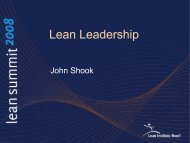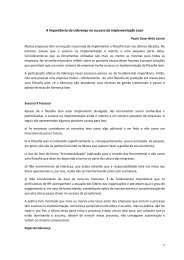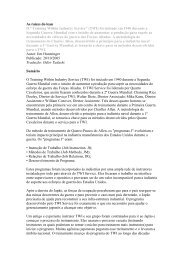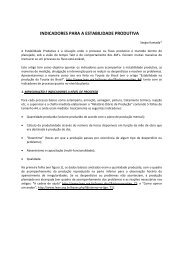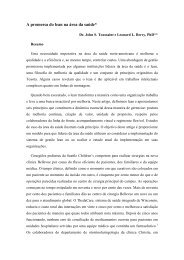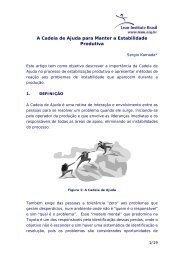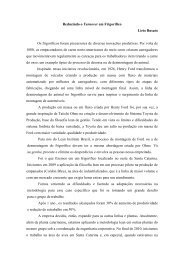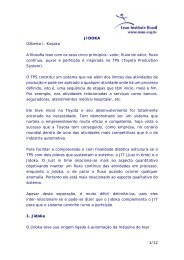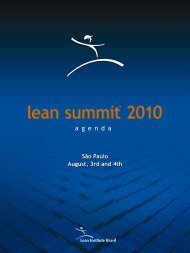Lean Leadership
Lean Leadership
Lean Leadership
You also want an ePaper? Increase the reach of your titles
YUMPU automatically turns print PDFs into web optimized ePapers that Google loves.
1<br />
<strong>Lean</strong> <strong>Leadership</strong><br />
John Shook
2<br />
Change –<br />
the leader’s role…<br />
“John, I can’t get my people to do this…”<br />
How can you get others to “do this”…?<br />
� Only one way…
4<br />
What is the Role of <strong>Leadership</strong>?<br />
Graphics slide. Place graphic within the white box.
5<br />
Mr. Cho of<br />
Toyota:<br />
Three Keys to<br />
<strong>Lean</strong> <strong>Leadership</strong><br />
Go See.<br />
• “Sr. Mgmt. must spend time on the plant floor.”<br />
Ask Why.<br />
• “Use the “Why?” technique daily.”<br />
Show Respect.<br />
• “Respect your people.”
6<br />
<strong>Leadership</strong>:<br />
Three Models<br />
• Old “Dictator”<br />
•<br />
•<br />
1970s “Empowerment”<br />
Style: “Do it my way…”<br />
Style: “Do it your way... ”<br />
<strong>Lean</strong> Style: “Follow me…<br />
and we’ll figure<br />
this out together ”
7<br />
Kan Higashi to Gary Convis…<br />
(NUMMI’s senior Japanese and American leaders)<br />
“Lead the organization as if you have no<br />
power."
8<br />
•<br />
•<br />
•<br />
•<br />
Toyota Way of Management<br />
From managing numbers to managing the process<br />
Leaders at Toyota, like leaders anywhere,<br />
want to see measurable results.<br />
But they know that the financial result is a<br />
result of a process.<br />
They also realize that the financial result<br />
is the result of the past performance of<br />
that process.<br />
Far better is to create a process that can<br />
be managed right NOW.
9<br />
Toyota Way of Management<br />
From the Five Who’s to the Five Whys<br />
•<br />
•<br />
•<br />
•<br />
Good Toyota leaders don’t jump to<br />
conclusions or solutions – they try to first<br />
size up the situation and then ask “Why?”<br />
This focuses on the work and problem at<br />
hand, avoiding the finger-pointing search<br />
for where to place the blame.<br />
It also keeps responsibility (ownership,<br />
accountability, authority-as-needed) with<br />
the person who is doing the work.<br />
This is what truly engages and empowers<br />
the workforce.
10<br />
Toyota Way of Management<br />
The “Why? Technique<br />
The “Why Technique” is key to management at Toyota.<br />
Not only is it used to solve problems (“Why did the<br />
machine break down?”) but to dialogue to reach mutual<br />
understanding (“Why do you say that?”) and agreement,<br />
and also to mentor others (“Why do you think that?”).<br />
The usual “Five Why’s”<br />
can be reversed:<br />
1. “Why did things go wrong; what is the root<br />
cause?”<br />
2. “Why do you propose that?”
11<br />
Toyota Way of Management<br />
From Problem-hiding to Problem-solving<br />
•<br />
•<br />
•<br />
•<br />
•<br />
All actions at Toyota revolve around<br />
planning and problem-solving.<br />
It is assumed that there will be problems,<br />
that everything will not go according to<br />
plan.<br />
“No problem is problem.”<br />
For the system to work, problems must be<br />
exposed and dealt with forthrightly.<br />
Hiding problems will undermine the<br />
system.
12<br />
Toyota Way of Management<br />
Control with Flexibility<br />
•<br />
Toyota’s way of managing provides<br />
extraordinary focus, direction, “control.”<br />
• While at the same time providing<br />
maximum flexibility.<br />
•<br />
This way of working can resolve the age-<br />
old dilemma that encumbers all large<br />
organizations: control vs. flexibility, or<br />
direction vs. adaptability.
13<br />
Innovation and Ownership,<br />
Responsibility and Authority<br />
•<br />
•<br />
•<br />
In my five years in Toyota City, almost<br />
never was I told exactly what to do or how<br />
to do it.<br />
Yet, I was not free to just do what I<br />
wanted.<br />
I was given clear responsibility to propose<br />
solutions to problems I owned.
14<br />
<strong>Leadership</strong> at Toyota<br />
Responsibility ≠ Authority<br />
•<br />
•<br />
•<br />
Not “bottom-up”<br />
or “top-down”.<br />
Processes well-defined and responsibility<br />
clear.<br />
From debate about “authority”<br />
(territory)<br />
to dialogue around “doing the right thing”.
15<br />
Innovation and Ownership,<br />
Responsibility and Authority<br />
•<br />
•<br />
•<br />
•<br />
•<br />
In a traditional hierarchical organization:<br />
Position establishes (or seems to) authority to<br />
make decisions.<br />
-> In cross-functional organizations, this<br />
causes confusion, frustration, and breakdown<br />
of the decision-making process.<br />
In a <strong>Lean</strong> Learning Organization:<br />
Position establishes responsibility to get<br />
decisions made.
16<br />
Chief Engineer or “Shusa”<br />
System<br />
Body Interior Chassis Elect. HR<br />
Eng.
17<br />
Toyota Way of Management<br />
From p-D-p-D<br />
•<br />
•<br />
to P-D-C-A<br />
Toyota would say this is essentially the P-D-C-<br />
A management cycle they learned from Dr.<br />
Deming.<br />
Probably. Yet this is precisely the thing that<br />
most companies can’t seem to do.<br />
• Why?<br />
•<br />
Surely one major reason for this is the way we<br />
lead and manage.
18<br />
From p-D-p-D Fire-fighting<br />
to P-D-C-A Management Cycle<br />
ADJUST &<br />
STANDARDIZE<br />
REFLECT<br />
GRASP the SITUATION<br />
ACTION<br />
CHECK<br />
STUDY<br />
PLAN<br />
DO<br />
HYPOTHESIS<br />
TRY
19<br />
<strong>Lean</strong> <strong>Leadership</strong><br />
The “Leader as Dictator” of the old days tried to tell everyone what to<br />
do.<br />
•No transfer, or Cascade of Responsibility<br />
The “Leader as Back-Slapper” of the 80s and 90s just set “goals”<br />
(MBO) and let everyone do as they pleased.<br />
•Loss of focus, direction, control
20<br />
<strong>Lean</strong> <strong>Leadership</strong><br />
•<br />
The <strong>Lean</strong> Leader leads a very different<br />
way:<br />
�…as different from the commonly<br />
accepted notion of the “enlightened<br />
modern manager” as it is the old<br />
command and control dictator.
21<br />
What can we do??<br />
Toyota is Toyota.<br />
We can learn from them, but we can’t copy them exactly.<br />
How can we operationalize the same principles in our own<br />
companies?
22<br />
Impact of <strong>Lean</strong> Transformation at<br />
different organizational levels<br />
MUST “DO”<br />
Role Impact<br />
MUST PROVIDE VISION<br />
AND INCENTIVE<br />
MUST LEAD THE ACTUAL<br />
OPERATIONAL CHANGE<br />
SENIOR<br />
MANAGEMENT<br />
MIDDLE<br />
MANAGEMENT<br />
FRONT LINES<br />
Likes the results<br />
Left with changed,<br />
uncertain role<br />
A Difficult Struggle at the Mid-management<br />
and First Line Supervisory Level<br />
Muri: overburden<br />
Mura: variation<br />
Muda: waste<br />
Likes<br />
the involvement
23<br />
System Design to Control the 3<br />
M’s<br />
•Muri –Overburden or unreasonableness to a<br />
person or a machine<br />
•<br />
•<br />
Mura – Instability; Unevenness; Variability;<br />
Inconsistency<br />
Muda –<br />
Waste<br />
The Seven<br />
Types of Waste<br />
Too much overtime!<br />
Stress!<br />
Not enough resources!<br />
- End of month deadlines with much overtime<br />
followed by periods of not enough work!<br />
- All projects scheduled in 1Q with none in 2Q!<br />
- Extensive IT everywhere yet not enough<br />
copy machines!
24<br />
Basic problem to solve at different<br />
levels of the enterprise<br />
MUST “DO”<br />
Role Problem: Impact<br />
MUST PROVIDE VISION<br />
AND INCENTIVE<br />
MUST LEAD THE ACTUAL<br />
OPERATIONAL CHANGE<br />
SENIOR<br />
MANAGEMENT<br />
MIDDLE<br />
MANAGEMENT<br />
FRONT LINES<br />
MURA & MURA<br />
Likes the results<br />
Problem:<br />
MURA & MURI<br />
Problem:<br />
MUDA<br />
Wants to be<br />
successful<br />
A Difficult Struggle at the Mid-management<br />
and First Line Supervisory Level<br />
Muri: overburden<br />
Mura: variation<br />
Muda: waste<br />
Likes<br />
the involvement
25<br />
PDCA Tools for different levels<br />
MUST PROVIDE VISION<br />
AND INCENTIVE<br />
MUST LEAD THE ACTUAL<br />
OPERATIONAL CHANGE<br />
MUST “DO”<br />
PDCA tool:<br />
Role Policy Management Problem: Impact<br />
PDCA tool:<br />
VSM or A3<br />
PDCA tool:<br />
Standardized Work<br />
SENIOR<br />
MANAGEMENT<br />
MURI & MURA<br />
MIDDLE<br />
MANAGEMENT<br />
FRONT LINES<br />
Likes the results<br />
Problem:<br />
MURA & MURI<br />
Problem:<br />
MUDA<br />
Provide the right tool for the right job<br />
Muri: overburden<br />
Mura: variation<br />
Muda: waste<br />
Needs the right tools<br />
and skills to be<br />
successful<br />
Likes<br />
the involvement
26<br />
Mr. Cho of<br />
Toyota:<br />
Three Keys to<br />
<strong>Lean</strong> <strong>Leadership</strong><br />
Go See.<br />
• “Sr. Mgmt. must spend time on the plant floor.”<br />
Ask Why.<br />
• “Use the “Why?” technique daily.”<br />
Show Respect.<br />
• “Respect your people.”
27<br />
“Data is of course important,<br />
but I place greater emphasis on<br />
facts.”<br />
“Go see”<br />
-Taiichi Ohno
28<br />
Core Toyota View:<br />
•“You can understand everything<br />
that is really important about a<br />
company by observing from a<br />
good spot on the plant floor.”
29<br />
•<br />
•<br />
•<br />
-<br />
What to look for<br />
let’s make it easy for ourselves…<br />
Plan vs. Actual<br />
Standardized Work<br />
Visuall y Confirm<br />
on the Shop Floor<br />
PDCA – the scientific<br />
method<br />
Tugger<br />
Route
30<br />
Mr. Cho<br />
“Know normal from abnormal…<br />
…right now!”<br />
Best Quality - Lowest Cost - Shortest Lead Time<br />
J<br />
I<br />
T”<br />
J<br />
I<br />
D<br />
O<br />
K<br />
A<br />
Operational Stability and Kaizen
31<br />
<strong>Lean</strong> Problem Solving<br />
- at the gemba<br />
-five whys<br />
GEMBA<br />
WORK FLOW<br />
DEFECT!!<br />
ENGINEER’S ROOM<br />
DATA<br />
TOOLS
32<br />
Respect for People<br />
Focus on the front line worker<br />
�Enable the worker<br />
�To work safely<br />
�To know his/her customer<br />
�To be involved, engaged<br />
�To be successful<br />
�Worker-out or the Front Lines-back principle<br />
�Build your operating system from the operator out<br />
�Remove wasteful steps from his work,<br />
�Giving it to support people: isolate the waste!<br />
�Until nothing is left but value-creating steps.<br />
�Don’t waste the operator’s time and effort!
33<br />
<strong>Lean</strong> <strong>Leadership</strong><br />
•<br />
The <strong>Lean</strong> Leader leads a very different<br />
way:<br />
�It is as different from the commonly accepted<br />
notion of the “enlightened modern manager” as it<br />
is the old command and control dictator.
34<br />
And what IS “<strong>Leadership</strong>”<br />
anyway??<br />
“The greatest leaders of the 20 th<br />
century<br />
were Hitler, Stalin and Mao: If that is<br />
“leadership”, I want nothing to do with it.”<br />
-<br />
Peter Drucker
35<br />
<strong>Lean</strong> <strong>Leadership</strong><br />
Practice of <strong>Leadership</strong><br />
vs<br />
Exercise of Power<br />
“I could put a loaded gun to your head…”<br />
True leadership exists when people follow when<br />
they don’t have to…”<br />
(James MacGregor Burns)
36<br />
Eiji Toyoda on <strong>Leadership</strong><br />
“The people at the top are just flag-wavers. It<br />
is pure MUDA to wave your flag and have no<br />
one follow you. Waving that flag in a way<br />
that makes people fall in line behind you is<br />
what is important.”<br />
�The Waste of Empty Flag-Waving
37<br />
•<br />
•<br />
The leader’s job at Toyota…<br />
First, get each person to take initiative<br />
to solve problems and improve his or<br />
her job.<br />
Second, ensure that each persons’<br />
job is aligned to provide value for the<br />
customer and prosperity for the<br />
company.
38<br />
The Leader’s job is to develop<br />
his or her people<br />
SPIRIT of <strong>Lean</strong> Mentorship:<br />
“If the learner hasn’t learned, the teacher hasn’t taught”
39<br />
Extensive Support and Coaching at<br />
the Front Lines of the Organization<br />
Foreman<br />
Group Leaders<br />
Team &<br />
Team Leader
40<br />
<strong>Lean</strong> <strong>Leadership</strong><br />
•<br />
The <strong>Lean</strong> Leader leads a very different way:<br />
�By setting the vision (more why than how)<br />
� with nemawashi dialogue, HK planning<br />
� and setting challenging expectations<br />
–<br />
–<br />
at the organizational level<br />
at the individual level<br />
�By building systems and processes that cascade<br />
responsibility<br />
� SW, KB, Stop-the-Line as tools that truly empower<br />
� HR and HK as broader empowering systems<br />
�By influence and persuasion<br />
� by example<br />
� by being knowledgeable<br />
� by getting into the messy details<br />
� by coaching and teaching<br />
–<br />
–<br />
through PDCA learning cycles<br />
through questioning
41<br />
If “managing” is about<br />
thinking...<br />
“leading” is about getting<br />
other people to think.<br />
-- David Verble
42<br />
If improvement is about taking<br />
responsibility and initiative<br />
Leading is about getting other<br />
people to take initiative
43<br />
How do you get other people<br />
to think ?<br />
and take initiative?
44<br />
Ask them Questions!<br />
What Questions?
45<br />
PDCA Questions<br />
What: is? is should might must<br />
not? be? be? be?<br />
What?<br />
Why?<br />
When?<br />
How?<br />
How?<br />
GRASP the SITUATION<br />
ACT<br />
CHECK -<br />
STUDY<br />
PLAN<br />
DO<br />
What?<br />
How?<br />
How?<br />
When? Who?<br />
What is?<br />
What is, is not?<br />
Why?
46<br />
What barriers<br />
discourage people<br />
from thinking and<br />
taking responsibility?
47<br />
What barriers discourage people<br />
from thinking and taking responsibility?<br />
•You, me or somebody<br />
rushes in to give them the<br />
answer.<br />
•It is more important to give<br />
them the right question than<br />
the right answer.
48<br />
•<br />
•<br />
•<br />
•<br />
•<br />
•<br />
•<br />
•<br />
•<br />
•<br />
The A3 Thinking Steps<br />
What is the problem?<br />
Who owns the problem?<br />
What is the root cause of the problem?<br />
What are some possible countermeasures?<br />
How will you choose which countermeasure to propose?<br />
How will you get agreement among everyone concerned?<br />
What is your implementation plan? What timetable?<br />
How will you know if your countermeasure works?<br />
What follow-up issues can you anticipate? What problems may<br />
occur during?<br />
How will ensure learning and continuous improvement?
49<br />
Background<br />
Why you are talking about it.<br />
Current Conditions<br />
Where things stand today.<br />
Show visually – pareto charts, graphs,<br />
drawings, maps, etc.<br />
Target/Goal(s)<br />
The specific outcome required for the<br />
business.<br />
Analysis<br />
The root cause(s) of the problem.<br />
Title: What you are talking about<br />
Choose the simplest problem-solving tool for<br />
this issue<br />
Proposed Countermeasure(s)<br />
Your proposal to reach the future state, the<br />
target condition.<br />
How your recommended countermeasures<br />
will impact the root cause to change the<br />
current situation and achieve the target.<br />
Plan<br />
A Gantt chart or facsimile that shows<br />
actions/outcomes, timeline and<br />
responsibilities. May include details on the<br />
specific means of implementation.<br />
Indicators of performance, of progress.<br />
Followup<br />
initials<br />
Remaining issues that can be anticipated.<br />
Ensure ongoing P-D-C-A. Yokoten as<br />
needed.<br />
Verble/Shook<br />
Owner
50<br />
Title: Create robust process for translating documents<br />
Background<br />
New domestic plant has massive technical<br />
requirements that must be translated from Japanese<br />
documents. The size and complexity of the project<br />
are creating errors and delays.<br />
Current Conditions<br />
Cost overruns. Delays. Errors. Complexity.<br />
Goal<br />
Reduce errors to manageable rate and simplify<br />
processes.<br />
Reduce cost by 10%.<br />
Analysis<br />
Challenge of translating from Japanese to English.<br />
Complexity and size and amount of documents. Problems<br />
stemming from multiple vendors.<br />
Recommendations<br />
Simplify and improve process performance by<br />
choosing one vendor based on competitive bid<br />
process.<br />
Plan<br />
Evaluate current vendor. Identify new vendor<br />
candidates. Develop bid package, distribute, and<br />
choose winning bid.<br />
Followup<br />
Monitor cost to proposal. Review performance at<br />
end of one-year contract. Put contract up for bid<br />
again if performance goals are not met.
51<br />
Title: Create robust process for translating documents<br />
Background<br />
New domestic plant has massive technical<br />
requirements that must be translated from Japanese<br />
documents. The size and complexity of the project<br />
are creating errors and delays.<br />
Current Conditions<br />
Cost overruns. Delays. Errors. Complexity.<br />
How much?<br />
Goal<br />
Reduce errors to manageable rate and simplify<br />
processes.<br />
Reduce cost by 10%.<br />
Analysis<br />
How long?<br />
How many?<br />
Why 10?<br />
“Massive”?? How big<br />
Or important is this problem?<br />
???<br />
???<br />
Challenge of translating from Japanese to English.<br />
Complexity and size and amount of documents. Problems<br />
stemming from multiple vendors.<br />
What do “challenge and “complexity” mean?<br />
What “problems?” What CAUSE??”<br />
Recommendations<br />
Simplify and improve process performance by<br />
choosing one vendor based on competitive bid<br />
process.<br />
Plan<br />
Evaluate current vendor. Identify new vendor<br />
candidates. Develop bid package, distribute, and<br />
choose winning bid.<br />
Followup<br />
What does number of vendors<br />
have to do with the problem??<br />
How can we know any of this will work when<br />
We don’t even know the problem or root cause?<br />
Monitor cost to proposal. Review performance at<br />
end of one-year contract. Put contract up for bid<br />
again if performance goals are not met.<br />
DP
52<br />
PDCA Questions<br />
•<br />
•<br />
•<br />
•<br />
Plan (hypothesis): What and why?<br />
No: “What can be done?”<br />
Yes: “What needs to be done?”<br />
Plan - Do: When?<br />
No: “How fast can we do it?”<br />
Yes: “When does it need to be done?”<br />
Check, Reflect: who, why?<br />
No: “What did you do?”<br />
Yes: “Why did you choose to do what you did?”<br />
Check – Act (Adjust): what, why?<br />
Not just: “Did you get the results?”<br />
But: “What did you learn?”
53<br />
<strong>Lean</strong> <strong>Leadership</strong><br />
•<br />
Traditional<br />
� � “<strong>Leadership</strong>” as noun: “leaders are born”<br />
•<br />
<strong>Lean</strong><br />
�“<strong>Leadership</strong>” �“<strong>Leadership</strong>” as verb: “take leadership”
54<br />
<strong>Lean</strong> <strong>Leadership</strong><br />
•<br />
How do you “Take leadership”?<br />
�Build �Build systems and processes, look for<br />
system/process solutions when things go wrong<br />
�Teach, �Teach, or “Facilitate learning”<br />
�Influence �Influence right thinking and action
55<br />
<strong>Lean</strong> <strong>Leadership</strong><br />
•<br />
How do you “Take leadership”?<br />
�Build �Build systems and processes, look for<br />
system/process solutions when things go wrong<br />
�� No: “My employee did the wrong thing”<br />
�� Yes: “What went wrong with my process?”<br />
�Teach, �Teach, or “Facilitate learning”<br />
�Influence �Influence right thinking and action
56<br />
<strong>Lean</strong> <strong>Leadership</strong><br />
•<br />
How do you “Take leadership”?<br />
�Build �Build systems and processes, look for<br />
system/process solutions when things go wrong<br />
�Teach, �Teach, or “Facilitate learning”<br />
�� If If the learner hasn’t learned, the teacher hasn’t taught<br />
�� Operations are a reflection of of management<br />
�Influence �Influence right thinking and action
57<br />
<strong>Lean</strong> <strong>Leadership</strong><br />
•<br />
How do you “Take leadership”?<br />
�Build �Build systems and processes, look for<br />
system/process solutions when things go wrong<br />
�Teach, �Teach, or “Facilitate learning”<br />
�Aim �Aim to influence right actions and thinking<br />
�� Model the behavior (right actions)<br />
�� Look for the thinking behind the actions
58<br />
The Thinking Production System<br />
Best Quality - Lowest Cost - Shortest Lead Time<br />
Through Shortening the Production Flow By Eliminating Waste<br />
Just in Time<br />
“The The right part<br />
at the right time<br />
in the right amount” amount<br />
•Continuous Flow<br />
•Pull System<br />
•Takt Time<br />
Leveled Production<br />
Operational Stability and Kaizen<br />
Getting people<br />
to think and<br />
take Jidoka<br />
initiative<br />
is the key!<br />
“Built Built-in in Quality” Quality<br />
•Automatic Machine Stop<br />
•Fixed Position Line Stop<br />
•Error Proofing<br />
•Visual Control<br />
•Labor-Machine Efficiency<br />
Production Lines<br />
That Stop for<br />
Abnormalities<br />
Standardized Work Robust Products and Processes<br />
Preventative Maintenance; 4S Supplier Involvement
59<br />
Change –<br />
the leader’s role…<br />
“John, I can’t get my people to do this…”<br />
How can you get others to “do this”…?<br />
� Only one way…
60<br />
<strong>Lean</strong> Enterprise Transformation<br />
Change Culture<br />
First<br />
(Conventional way)<br />
Change System<br />
First<br />
(<strong>Lean</strong> Way)<br />
Where Do You Start - From Top or Bottom?
61<br />
<strong>Lean</strong> Enterprise Transformation<br />
It’s easier to act<br />
your way to a new<br />
way of thinking<br />
than to think your<br />
way to a new way<br />
of acting.
62<br />
Sr.<br />
Mgmt.<br />
Middle<br />
Mgmt.<br />
Front<br />
Lines<br />
System Kaizen<br />
Eliminate<br />
Muri and Mura<br />
FOCUS<br />
Process-step Process step Kaizen<br />
Eliminate Muda



